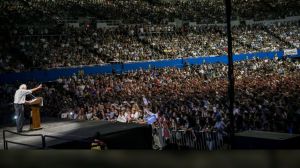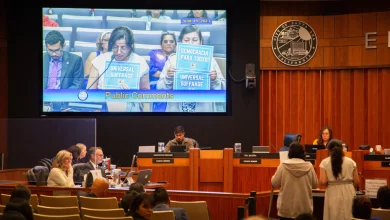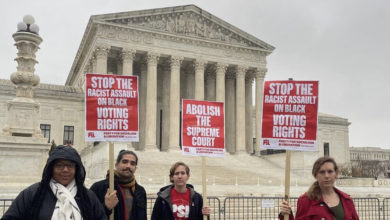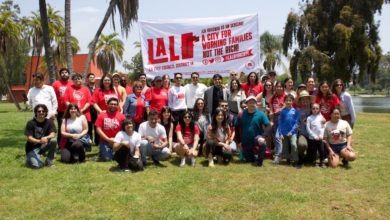
The Party for Socialism and Liberation is running a revolutionary socialist election campaign in 2016, with Gloria La Riva as our candidate for president and Eugene Puryear for vice-president. For more information and to get involved, visit VotePSL.
The 2016 election promises to be the most expensive and corrupt in history, with rivers of cash flowing directly from the accounts of billionaires, corporations and mega-banks into the coffers of the leading Republican and Democratic Party contenders. This unlimited funding of candidates by the super-rich was legalized by the Supreme Court’s decision in the 2011 Citizens United case, resulting in their near-complete domination of campaigning funding. For example, one extreme right-wing Republican candidate, Ted Cruz, has received $36 million from just five individuals, with the first primary election still a half-year away.
In the 2012 presidential campaign, the 100 biggest donors gave at least as much money to the candidates as 4.7 million small donors, according to the Brennan Center for Justice.
An unexpected response to this obscene form of “dollar democracy,” rapidly widening inequality, and other regressive developments has come in the form of the Bernie Sanders election campaign. Sanders, an Independent senator from Vermont and self-described socialist, is seeking the Democratic party nomination for president against Hillary Clinton and others. When he announced his campaign in late April, Sanders was regarded as a kind of novelty candidate.
But Sanders, stunning the political establishment, has been drawing far and away the largest and most enthusiastic crowds of any candidate, Democrat or Republican—28,000 in Portland Ore., 27,000 in Los Angeles, 15,000 in Seattle, more than 10,000 each in Wisconsin and Arizona, and 8,000 in Dallas. Thousands more have packed convention centers and auditoriums in Louisiana, Colorado, Vermont, Iowa and other states.
On July 28, a reported 100,000 people participated in 3,500 “virtual house parties,” where they were addressed by the candidate speaking from a home in southwest Washington, D.C. In sharp contrast to other candidates, more than 80 percent of Sanders’ campaign contributions, now totaling more than $17 million, are less than $200, with an average donation of $31.21.
The Sanders campaign is drawing support from some unions, including an endorsement by the National Nurses United, the largest nurses union. More than 5,400 labor officials and activists from a wide range of unions have signed on to “Labor for Bernie.”
Sanders still trails the faltering Democratic front runner Hillary Clinton in nationwide polls by a margin of about 20 percent, but the gap in some of the early primary states has now shrunk to single digits, and in New Hampshire, a recent poll shows Sanders leading Clinton.
What explains the surge in support for the Sanders campaign and how should revolutionary socialists respond to it?
Sanders’ program—reformist not socialist
While Sanders calls himself a “democratic socialist,” his program is not socialist, nor does the word appear on his campaign website. He does not call for nationalizing the corporations and banks, without which the reorganization of the economy to meet people’s needs rather than maximizing the profits of capitalist investors could not take place. In his speeches, he advocates for a “political revolution,” but he is clearly seeking to reform the existing capitalist system.
On foreign policy, Sanders’ stance is that of a mainstream imperialist Democrat. He opposed the 2003 invasion of Iraq but supported the 1999 U.S./NATO bombing war against Yugoslavia. He is critical of some of Israel’s most extreme actions but is a supporter of the massive U.S. aid to the Israeli military.
What makes Sanders’ campaign different and what has attracted such enthusiastic support is his reform program, a program that appears to be a radical departure in the present political climate. Sanders calls for a $15 minimum wage, the right of workers to unionize, a federal jobs program, taxing the rich, free tuition at public universities, universal health care, measures to reduce global warming, women’s reproductive rights, overturning of the Citizens United decision and limits on campaign contributions, expanded voting rights, prison reform, an end to “structural racism” and racial profiling, and a “path to citizenship” for undocumented immigrants. He has been a vocal opponent of the XL Pipeline, the Trans-Pacific Partnership, and NSA warrantless surveillance of people inside the United States.
Sanders’ program also calls for guaranteed two weeks’ vacation, 10 sick days, and up to 12 weeks’ paid family leave (the latter to be paid for by a tax on workers), among other issues. Millions of workers presently have zero guaranteed vacation, sick time or family leave, putting the United States at the very bottom among all industrially developed and many developing countries.
In many respects Sanders’ reformist economic program resembles Jesse Jackson’s electoral challenge to the Democratic Party establishment in the 1984 and 1988 primaries, and like Jackson, Sanders almost certainly will not run an independent campaign. What is very different is that the Jackson campaign was firmly anchored in the African-American community, which overwhelmingly supported Jackson’s candidacy.
So far, Sanders has drawn mainly, though not exclusively, white crowds and has done the best in predominantly liberal areas.
In recent campaign appearances in Arizona and Washington State, Sanders’ speeches have been disrupted by activists from the Black Lives Matter Movement, which has emerged as a dynamic new force over the last year, demanding that he take a much stronger position on the issue of racist police killings.
The Sanders campaign has recently issued a position paper, titled “Racial Injustice,” and his campaign has stepped up its efforts to expand its support among nationally oppressed communities. At the same time, Sanders has appeared dismissive of the movement, failing to calm booing crowds and exhibiting a generally gruff attitude towards being disrupted.
With so long to go before any actual voting, it remains to be seen how the Black electorate will ultimately react to Sanders’ candidacy.
The Sanders campaign and the revival of socialism in the United States
Of major significance is that this massive outpouring of support is for a candidate who calls himself a socialist, in a country whose politics have been for so long dominated by virulent anti-communism and anti-socialism. Throughout the history of the United States, socialist presidential candidates have invariably been relegated to the margins. The fact that in 2015 a candidate who calls himself socialist is drawing huge crowds must be understood as a significant political development, regardless of the fact that his program is not revolutionary.
In a related development, earlier this summer, a Gallup poll asked the question, “Between now and the 2016 political conventions, there will be discussions about the qualifications of presidential candidates—their education, age, race, religion, and so on. If your party nominated a generally well-qualified person for president who happened to be a socialist, would you vote for that person?” A surprising 47 percent of those polled said that they would, including 70 percent of 18-29 year olds.
It is clear that what is driving the response to the Sanders campaign is the desire on the part of a huge number of people for profound political change. The election of Ksahma Sawant to the Seattle City Council, the Gallup poll and others like it, and now the Bernie Sanders campaign are clearly part of a broader trend of an explicit, if amorphous, emergence of socialism as a major oppositional trend to the oppressions and exploitation of daily life.
It has its corollary in the streets in the new labor movement bubbling up in low-wage workplaces, the Black Lives Matter Movement, those fighting for justice and dignity for immigrant communities, and to save the planet.
As revolutionary Marxists, we in the Party for Socialism and Liberation regard this as fertile ground for a movement that can truly uproot the capitalist system.
Over the next 15 months leading up the 2016 election, the La Riva/Puryear PSL Campaign will seek to reach out to the millions—including Sanders’ supporters—through our activism in the struggle, while tirelessly explaining that only the revolutionary reorganization of society can truly achieve what the people and the planet most desperately need—socialism!
We call on all those who agree to join us.






